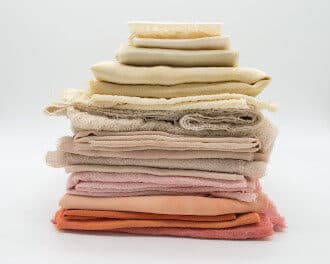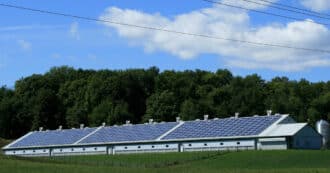By Ethel Mendius – Sleep sets the tone for our health and mindset. Sustainable bedding is a choice with benefits both for our bodies and our planet.
Sustainable Lifestyles
The devastating effects of climate change have increased the global demand for sustainability. The UN defines sustainability as “meeting the needs of the present without compromising the ability of future generations to meet their own needs.”
Turning the tide on climate change requires international political effort and an overhaul of corporate policy; it is estimated that “just 100 companies [are] responsible for 71% of global emissions.”
That being said, the climate crisis also requires effort and lifestyle changes from every one of us. By becoming conscious consumers, we can lead by example and strive for a greener future.
Corporate Responsibility
The choices we make have a ripple effect. By being ethical consumers, we put pressure on companies to enact corporate responsibility and commit themselves to the values of their consumers.
In practice, this includes “reducing their carbon footprint [and] limiting fossil fuels.” By demanding sustainability through our choice of bedding and other products, we can have a good night’s sleep knowing we our doing our part.
The Benefits Of Sustainable Bedding
Environmentally friendly bedding benefits people and planet alike: “Eco-friendly bedding is made with fabrics that boast benefits like moisture wicking and antibacterial properties and are, generally, easy to recycle.”
In addition to these conveniences, the environmental impact is vast. Sustainable products “don’t require harsh chemicals like pesticides or bleach or inexpensive and dangerous additives like microplastics.”
These advantages are interlinked with human health. Toxic dyes and chemicals used in traditional bedding “can end up in our drinking water and soil, eventually infiltrating our bodies.”
Eco friendly bedding is a win-win, better for us and the planet. We spend a third of our lives in our beds, so it makes sense to give some thought to sustainable bedding.
What Makes Bedding Sustainable?
With many brands touting sustainability, there are a plethora of options for conscious consumers. It can be a challenge to know what to look for.
In reality, some sustainable bedding brands are better than others. Shoppers must look past buzzwords and greenwashing to determine what is the most sustainable choice.
In addition to the product itself, it is important to pay attention to the ethos of the company. For example, many eco friendly bedding brands “promote social action, too.”
This could mean “planting a tree per purchase, exploring alternative energy options, practicing people-first employee ethics, and equal pay.” These are advantages to consider before buying.
Eco Friendly Materials
The biggest factor of sustainable bedding is the materials being used. Organic materials are a better choice for your own health and the well being of the planet.
The Problem With Cotton
When it comes to fabric, cotton is the obvious natural choice. However, not all cotton is made and manufactured sustainably.
Conventional cotton is actually known as the world’s “dirtiest” crop because of the pesticides and insecticides it requires to grow. This type of cotton production accounts for “16% of the world’s insecticides.”
The toxic chemicals infiltrate the environment and do serious harm, compounded by water-intensive irrigation techniques. Organic cotton is a sustainable alternative that mitigates these risks.
Organic Cotton
Organic cotton is “grown without harmful chemicals, leaving the soil, air and water free from contaminates.” It also uses much less water, “since organic cotton growers typically utilize rain far more than irrigation.”
Instead of harming living creatures with toxic chemicals, “organic cotton growers use beneficial insects to control unwanted pests… thus encouraging biodiversity.” When it comes to eco friendly fabrics, organic cotton is a no-brainer.
These benefits mean shopping for organic cotton slows climate change, by virtue of its smaller carbon footprint: 46% less carbon dioxide is produced in the manufacturing process.
GOTS Certified Organic Cotton
Look out for cotton with Global Organic Textile Standard (GOTS) certification. GOTS “is the world’s leading textile processing standard for organic fibers,” including cotton.
GOTS ensures organic materials are used throughout every stage of the product’s lifecycle. This includes “harvesting of the raw materials through environmentally and socially responsible manufacturing all the way to labeling.”
Other Materials
Cotton is one of many organic fabrics certified by GOTS. You can also shop for bedding made from organic linen, organic hemp, or even eucalyptus.
Natural fibers often come with a higher price tag and do not provide all the features of synthetic materials. In this case, Tencel sheets are a realistic alternative.
Tencel is known for its temperature regulating properties and silky feel. It may appeal to shoppers looking for year round sheets at a lower price than most certified organic cotton sheets.
Tencel is preferable to other synthetics. However, it is important to remember it is “better for the environment than other similar fabrics, but not as sustainable as top-tier fabrics like organic linen or recycled cotton.”
Fair Trade Materials
Eco friendly bedding is important, but not the only aspect of sustainability. Ethical considerations about how materials are sourced must also inform your purchase.
True sustainability is fair trade as well as environmentally sustainable: “This includes how textiles are produced and manufactured, labor standards, and wages.”
Fair trade standards protect the farmers and workers who manufacture bedding and other goods. Fair trade refers to both the production of raw materials and the finished product.
Fair Trade Certification
Fairtrade International is a global certification standard that ensures “workers’ rights, safer working conditions and fairer pay.” They also promote environmentally friendly practices in their partners.
Other organizations, such as the World Fair Trade Organization and Fair Trade USA, set standards and promote fair trade products. Many products are called “fair trade”, so ensure the one you are buying has been vetted.
Sustainable Bedding Brands
There are so many sustainable bedding brands you can choose from. To begin, here is a shortlist of eco friendly and organic bedding brands.
Under the Canopy is a long time leader in sustainable bedding. Their products are made from certified organic products and recycled materials.
West Elm is known for sustainable, fair trade bedding and furniture. West Elm offers a wide range of bedding made from GOTS certified textiles.
SOL Organics is an affordable organic bedding brand, “made in fair trade factories that do not employ child labor.” Their products use 100% organic cotton and non toxic dyes.
Pact is another brand that uses organic cotton and fair trade factories to produce sustainable bedding at a reasonable price. In addition, they offer minimalized packaging and carbon offsetting in their shipping.
The brand right for you depends on your needs, preferences, and budget. If you feel unsure, consult an eco friendly brand directory such as good on you to compare your options.
Sustainable Bedding For All Consumers
A sustainable lifestyle can take many different forms. High-end shoppers might appreciate the opportunity to make an ethical purchase with a sustainable luxury brand.
As we have considered, there is a range of affordable eco friendly bedding options. There is no need to break the bank for sustainable bedding, or any other good.
The essence of sustainability is a waste free lifestyle. It is not about where you shop as much as your attitude towards what you buy.
Sustainability is for everyone. Each of us can use our available resources to meet our needs and enhance our lives while skipping out on what is not essential.
Sustainable Bedding And Religion
Many companies that want to produce bedding from a more sustainable source are turning towards eucalyptus. Eucalyptus is a more sustainable bedding material for many reasons, as described on good on you:
Eucalyptus trees are felled rather than uprooted, meaning that there is no need to continuously plant new trees. They also grow quickly, don’t need irrigation or pesticides, and can grow in relatively poor, dry, and rocky soil.
Lenzing have demonstrated that it is possible to create a closed-loop system in the manufacturing of lyocell: they manage to recover and reuse 99% of the solvent in new processing cycles. In addition, the solvent is considered non-toxic for air and water. This approach minimizes any environmental impacts. And, crucially, the wood used by Lenzing originates from sustainable forestry—more on this below.
When compared to conventional cotton, the lyocell production process used 50% less water.
Finally, in terms of product use and end-of-life, lyocell doesn’t release toxic microfibers—a significant advantage over synthetic fabrics—and is recyclable and biodegradable.
Eucalyptus has a deep history in Aboriginal traditions. The Joy of Plants discusses how “The eucalyptus is a holy tree for the Aboriginals. For them it represents the division of underworld, Earth and heaven.”
Eucalyptus is a holy tree, but that doesn’t mean that it’s always a sustainable source. “Good on you” points out that eucalyptus can be harvested unsustainably if it is grown through cutting down native forests to grow eucalyptus through intensive monocultures.
Another issue is when eucalyptus trees are stolen from indigenous peoples who want to protect their trees. A Guardian article describes how the “Djab Wurrung people are trying to stop the Victorian government from cutting down sacred eucalyptus trees, including birthing trees where countless generations of their people have been born.”
Understanding the blessings of eucalyptus and the dangers in its exploitation offers us a reminder: sustainability is more than one-size-fits-all solutions. Sustainability needs to be part of a broader consciousness of environmental, cultural and spiritual awareness to truly transform our world.
We all have a role to play in healing our world. But first, we need to learn to listen.
* Featured image source








